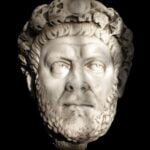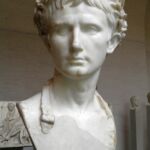Chapters
After the death of Alexander Severus in 235 CE, the last member of the Syrian dynasty, The Roman Empire experienced an economic and political crisis. It was adopted as the “crisis of the third century” and lasted until the rule of Diocletian in 284 CE. At this time, the Roman Empire, constantly destabilized by its internal struggle for power it had to defend its borders against attacks by neighbouring peoples and states.
The crisis of the third century historians also call “the age of anarchy”; “transition period”, “era of soldiers-emperors” and “military monarchy”. The visible symptom of the crisis was political instability as manifested in the rapidly changing changes of emperors, from Septimius Severus. Most of them rose to power through military coups, held power for several months, and often died at the hands of their own soldiers in the course of another coup. In total, in the years 235-284 CE at least 51 people received, legally or not, the title of emperor. During this period, the first time a Roman emperor was killed in battle or enslaved – Emperor Valerian I (253-260 CE) was captured by the Persian king Shapura I during the defense of the Roman lands invaded by the Persians, and Decius died in a clash with the Goths.
During this period, the city of Rome lost its political importance as the emperors spent most of their time in the provinces defending the invaded lands; and since the rulers were proclaimed by legions, the emperor did not need the approval of the senate or the Roman people. Many emperors of this period did not visit Rome even once during their reign, residing in other imperial cities such as Nicomedia, Trier and Milan.
The period of crisis can be conventionally divided into 4 sub-periods. In the first of them, lasting from the death of Alexander Severus to the death of Decius (235–251 CE), a gradual build-up of the signs of crisis was characteristic, with simultaneous unsuccessful attempts to restore the pre-crisis situation. In the second sub-period, from the death of Emperor Decius to the capture of Valerian II (251-260 CE), the greatest signs of a breakdown were visible, with almost no counteraction at the same time, as the existing possibilities had been exhausted and new methods had not yet been found.. The third subperiod covering the mono-rulership of Galiena (260-268 CE) is characterized by the persistence (or even build-up) of signs of crisis with simultaneous reforms that in the future, they made it possible to overcome the crisis and build a state with a new constitutional form (dominat). The last sub-period from the death of Galien to the assumption of power by Diocletian (268–284 CE) is characterized by the gradual overcoming of the crisis and the building of the political foundations of the dominate.
Raids
The military crisis of the third century is related to the aggression of the neighbors of the empire: the Persian Sassanid monarchy, which replaced the Parthians as rulers of Persia in 224 CE, and the pressure of the northern tribes – along the Rhine and Danube, attacks were repeated by the Karpovs, Goths, Vandals, and Alamans. Climate change and the rising sea level have caused great damage to agriculture, which in turn has forced the barbarian tribes to search for new land for cultivation.
To make matters worse, in 251 CE there was the so-called The “Plague of Cyprian” – probably smallpox – which killed a certain part of the Empire’s society and indirectly adversely affected the Empire’s defense capabilities.
The barbarian raids plagued virtually all the western and northern provinces of the empire, as well as Cappadocia, Achaia, Egypt and Syria. Frequent changes to the throne also led to internal fights and civil wars. After the death of Valerian I in CE 260, the crisis deepened. In the years 258-274 CE, Gaul functioned semi-independently as the so-called the Gallic Empire under Postumus and his successors. After the death of Septimius Odaenathus – king of Palmyra in CE 267, the eastern provinces of Syria, Palestine and Egypt declared independence and formed the Palmyra Empire under Zenobia.
The invasion of large groups of Goths was stopped in CE 269 at the Battle of Nis. It was a turning point as energetic soldiers-emperors began to come to power. The victories of Claudius II of Gothic over the next two years allowed the Alamans to be pushed from the borders of the Empire and to wrest Spain from the hands of the Gallic Empire.
In 270 CE, Claudius died of a plague and was replaced by Aurelian, the cavalry commander of the Battle of Niš. The new emperor continued the policy of stabilizing the Empire. During his reign (270-275 CE), the state experienced the most difficult period. The empire led by Aurelian defeated the Vandals, Visigoths, Palmyra, Persians and finally ended the Gallic Empire. In 274 CE, Rome was practically one political entity. However, a series of wars and rivalries for power resulted in many cities in the west of the Empire being ruined and the population partially wiped out. This, in turn, brought about a severe economic crisis that made it impossible to rebuild the pre-235 economy in the future.
Despite the fact that Aurelian had stabilized the Empire and led it out of the crisis, some problems still remained unresolved. The state stretched over vast territories that were poorly administered and too vast for a single leader to be in charge. Another problem was the succession of power – it became common that the title of Augustus fell into the hands of local leaders who were proclaimed emperors by their troops. Such issues forced the later Emperor Diocletian to thoroughly reform the Empire and shape the so-called tetrarchy. In this way, we managed to strengthen the country for the coming years.
Economic crisis
The need to defend the borders against the invasions of the Germanic tribes and the Persian army forced the emperors to over-expand their army, the cost of which increased and the Roman economy was unable to bear them. In the supply system, the emperors imposed enormous fiscal burdens on the population and supplemented the shortages in the treasury by the so-called “spoiling the coin”, ie circulating a coin that, instead of precious metals, contained a large admixture of base metals. The “spoilage of the coin” led to hyperinflation, which was attempted to be contained by the tools of the command economy. On the other hand, the tax authorities did not want to charge the tax in a worthless coin, but instead in products. The imperial economy thus reverted to the state of a commodity economy.
The effect of the political destabilization of the Empire and the constant struggle was a marked decrease in trade within the Empire. Merchants did not feel safe on the routes, while the big owners of latifundia, instead of exporting their goods to the outskirts of the country, preferred to act locally. Social stratification also deepened. Small farms collapsed – they were bought or, on their own initiative, were handed over to noblemen. Protection (patrocinium) guaranteed a chance of survival and shaped the colony layer.
The development of Roman latifundia went hand in hand with their independence from state power. From the 3rd century on, the owners of property complexes were increasingly excluded from the municipal administration, common judiciary and the tax system. As a result, the colonies’ dependence on latifundists deepened, and state structures lost contact with the basic layer of the population. The rulers of the late empire did not fight these tendencies effectively. The transfer of the obligation to collect taxes and appoint recruits to latifundists encouraged even the emperors to increase the dependence on the colonies.
The rapid development of the colony, and hence great land ownership, in the last centuries of the Empire’s existence is considered one of the reasons for its collapse. In the longer term, the colonies also had a clear influence on the development of a new social system – feudalism. The owners of latifundia gradually ceased to feel obliged to serve the state. They became local rulers who had a large group of fellow citizens under their protection. Thus, there was a clear loosening of inter-social ties.
Consequences
As a result of the constant threat, the great and open cities of antiquity began to change their character. The centres began to transform into small and fortified towns that were characteristic of the later Middle Ages. Naturally, the process of transforming buildings was slow and took centuries, but its beginnings could be noticed already in the 3rd century CE. Thus, in the events of the 3rd century CE, certain processes that led to the rise of the Middle Ages can be clearly seen.
Moreover, Roman trade never regained its high level from the so-called Pax Romana (27 BCE – 180 CE). As a result of the fighting, the western part of the Empire suffered much more than the eastern provinces, which resulted in a disproportion in development. This led future emperors to favour eastern cities and to shift the centre of gravity to the east. Evidence of this was the country’s management by Diocletian of Nicomedia in Asia Minor when his deputy Maximian was residing in Milan.
The Roman Empire, although it survived the “great crisis”, emerged from it very weakened and became more vulnerable to future threats.









